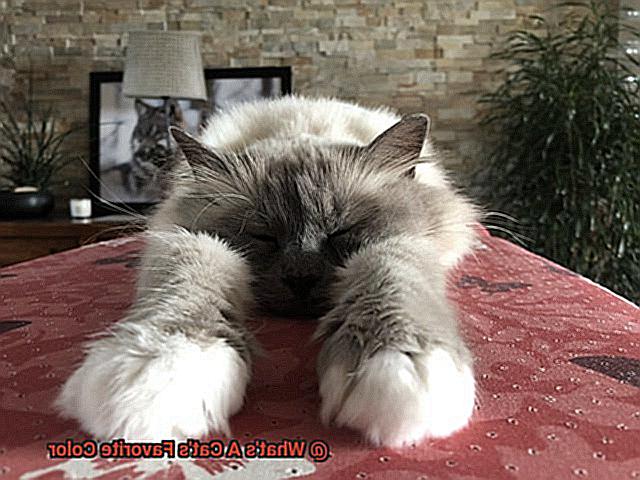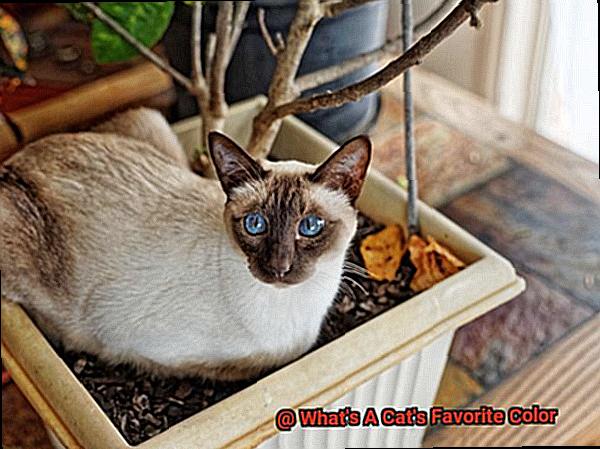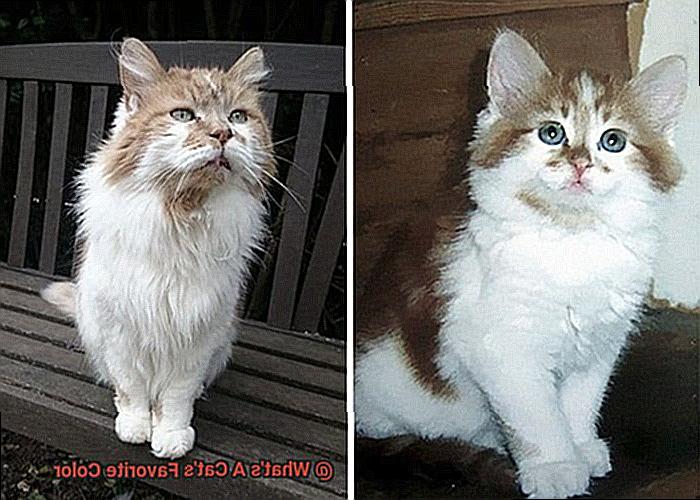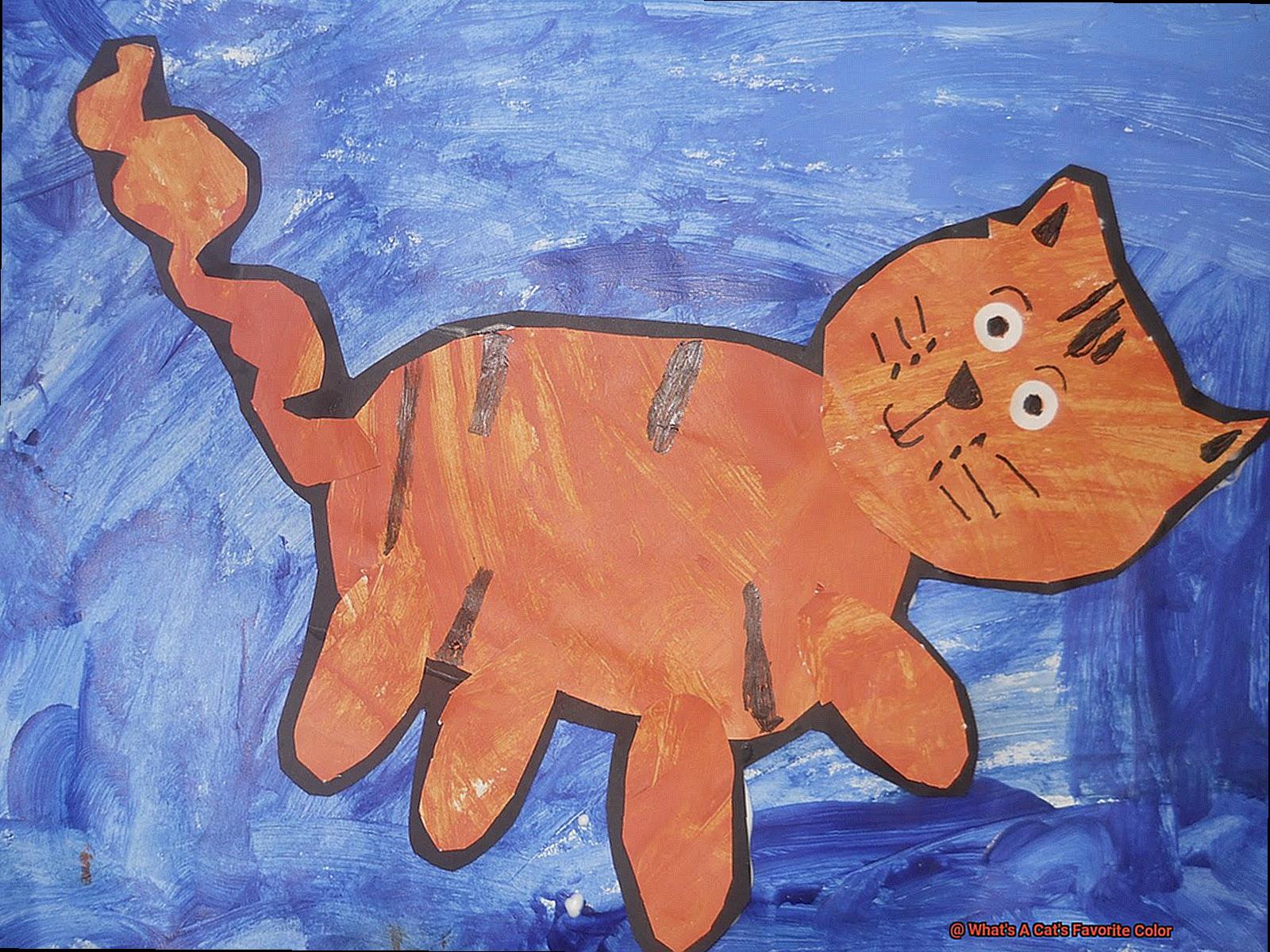Cats are a fascinating species, full of quirks and surprises.
Their unique personalities and behaviors have captivated humans for centuries. But have you ever wondered if cats have a favorite color?

Do they see the world in black and white or are their eyes attuned to a specific hue? In this blog post, we’ll explore the intriguing question of What’s A Cat’s Favorite Color.
We’ll dive deep into the science behind feline vision, uncovering how they perceive colors differently from humans. We’ll also take a look at the research that has been done on cats’ color preferences and what it could mean for you as a cat owner.
Have you ever noticed your furry friend being drawn to certain colors? Maybe they can’t resist chasing after that vibrant yellow toy mouse or batting around a blue feather wand.
As we delve into the world of cat color preferences, we’ll discover that there’s more to it than meets the eye. So sit tight and get ready to learn about What’s A Cat’s Favorite Color.
It’s an exciting topic that will give you a new appreciation for your feline companion and their unique perspective on the world around them.

Do Cats Have a Favorite Color?
This question may not have a straightforward answer because cats don’t see the world the same way that humans do.
They have dichromatic vision, which means they can only see shades of blue and green. This makes their color perception less vibrant and nuanced than ours.
However, research has shown that cats do have preferences when it comes to certain colors. Cats are instinctively attracted to colors that resemble their prey, which tends to be shades of blue and green.
This could be why many cats enjoy playing with toys in these colors or watching birds on TV screens. Interestingly, some studies suggest that cats may be turned off by certain colors like red and orange.
These hues are associated with danger and aggression in the animal kingdom, which could explain why cats may be less attracted to them. While cats may not have a specific favorite color, they do seem to have individual preferences based on their natural instincts and experiences.
Brightly colored toys with contrasting colors can be visually stimulating and fun for cats to play with. Additionally, the color of their surroundings can impact their mood and temperament.
For instance, an anxious or stressed cat may prefer calming colors like blues or greens, while a more outgoing cat may enjoy brighter colors like orange or pink. As a cat owner, it’s important to observe your cat’s behavior to understand their preferences fully.
Experimenting with different colors of toys and accessories can be a fun way to engage with your feline friend, cater to their individual needs, and provide them with a stimulating environment.
How Do Cats Perceive Colors?
It turns out that cats have a different way of perceiving colors compared to humans.
While humans have three types of color-sensitive cones in their eyes, cats only have two. This means that they see colors differently than we do, and their range of color vision is more limited.
Despite this, cats are able to distinguish between certain colors, particularly blues and greens. However, they have difficulty differentiating between reds and yellows.
To a cat, these colors may appear as shades of gray or blue. This is because the wavelengths of light that correspond to these colors are absorbed by their eyes, making it challenging for them to distinguish them from other colors.
But don’t be fooled by their limited range of color vision. Cats make up for it with exceptional night vision.
Their eyes are specially designed to pick up even the slightest movements in low light conditions, making them outstanding hunters and predators. It’s worth noting that a cat’s perception of color can be affected by age and health.

As cats grow older, their eyesight may deteriorate, making it more challenging for them to differentiate between colors. Moreover, certain health conditions can impact a cat’s vision and perception of color.
For instance, if a cat has cataracts or other eye problems, it can affect their ability to see colors clearly. Understanding how cats perceive colors can help us provide better care for our beloved pets.
While your cat’s range of color vision may be more limited than yours, they still have exceptional night vision that allows them to navigate in low light conditions like the stealthy predators they are.

What Toys Do Cats Prefer?
Toys are a great way to achieve this, but with so many options available, it can be challenging to know what toys your cat will enjoy. That’s why we’ve put together this comprehensive guide to help you answer the question “What toys do cats prefer?”
The Classic Ball or Mouse Toy
The classic ball or mouse toy is a staple in most cat households, and for a good reason. These toys mimic the movement of prey, encouraging cats to pounce and chase. They come in various sizes and designs, allowing you to find the perfect one for your cat’s preferences.
Some cats prefer larger balls that they can kick around, while others enjoy smaller toys that they can carry in their mouth.
No matter what size or design you choose, these classic toys are sure to provide your cat with plenty of exercise and mental stimulation.
Interactive Toys
Interactive toys are a great way to bond with your cat while providing them with mental stimulation. Wand toys, laser pointers, and puzzle feeders are just a few examples of interactive toys that cats love.
Wand toys are particularly popular because they allow you to control the movement of the toy, making it more exciting for your cat. Laser pointers are also great because they provide an irresistible light beam that cats love chasing around the room.
Puzzle feeders provide your cat with a challenge that rewards them with a tasty treat, making them perfect for cats who enjoy problem-solving.
Scratch Posts and Pads
Scratching is a natural behavior for cats that helps them stretch their muscles and maintain healthy claws. However, if your cat starts using your furniture as a scratching post, it can quickly become destructive.
Scratch posts and pads provide an outlet for your cat’s scratching behavior while protecting your furniture. They come in various shapes and sizes, allowing you to find one that fits your cat’s preferences. Some scratch posts even come with added features like toys and perches to make them more enticing for your cat.
Plush Toys
Plush toys are perfect for cats who enjoy cuddling or carrying their toys around. They come in various shapes and sizes, from small mice to larger stuffed animals. Some cats even develop a special attachment to their plush toys, treating them like a security blanket. When choosing a plush toy for your cat, make sure it’s made with safe materials that won’t harm them if they chew on it.
Experimenting with Different Types of Toys
Every cat is unique, and what works for one may not work for another. It’s essential to experiment with different types of toys to find out what your cat likes best.
Some cats may prefer more active play, while others enjoy quieter activities like lounging on a soft bed or playing with a plush toy.

How Can Cats’ Moods Influence Their Color Preferences?
Cats are fascinating creatures with complex personalities that can change in a heartbeat.
Just like us humans, they can experience a range of emotions, from playful and energetic to calm and relaxed. But did you know that a cat’s mood can also affect their color preferences?
The colors of their toys, bedding, and even food bowls can play a crucial role in their overall happiness and contentment.

Research has shown that cats are more likely to choose colors that match their current mood. For example, a cat feeling playful may prefer toys in bright and vibrant colors that match their energy levels, while a cat feeling calm and relaxed may opt for more muted and soothing tones.
So, if you want to keep your furry friend happy and entertained, it’s important to pay attention to their current mood and select toys and accessories accordingly. In one study, cats were presented with a choice between two toys – one in a bright color and the other in a muted color.
The results revealed that cats who were feeling playful tended to choose the bright toy, while cats who were feeling relaxed tended to go for the muted one. This suggests that cats have an innate ability to gravitate towards colors that match their current state of mind.
Another fascinating finding from research is that cats may have an inherent preference for colors that are similar to their fur. A study found that cats were more likely to approach food bowls that were the same color as their fur.
This could be because cats feel more comfortable and secure with colors that match their own appearance. It’s important to note that each cat is unique and may have their own individual color preferences based on their personality and experiences.

However, understanding how a cat’s mood can influence their color preferences can help pet owners make better-informed decisions when it comes to choosing toys, bedding, and other accessories for their feline friends.
So, by keeping your cat’s mood in mind when selecting toys and accessories, you can help them feel more comfortable and at ease.
What Are the Best Colors for Cat Owners to Use in Their Surroundings?
While cats may not have a favorite color, research shows that certain colors can have a calming effect on them.
By using the right colors in your cat’s living space, you can create an environment that promotes relaxation and happiness. Soft, muted colors like blues and greens are perfect for creating a tranquil atmosphere in your cat’s surroundings.
These colors can be incorporated into their bedding, furniture, and even the wall color of the room. The soothing tones of blue and green evoke feelings of calmness and peace, making them ideal for cats who need to unwind after a long day of play.
On the other hand, bright and bold colors like reds and oranges may be too stimulating for cats. These hues can cause anxiety and stress in your furry friend, so it’s important to balance them out with softer tones.
By mixing calming and stimulating colors, you create a harmonious environment that keeps your cat feeling relaxed and content. It’s also worth considering your cat’s personality when selecting colors for their living space.
Some cats may prefer warmer tones like yellows or pinks, while others may gravitate towards cooler blues and greens. By observing your cat’s behavior and mood, you can determine which colors they respond best to.
So, incorporating soft, muted colors like blues and greens into your cat’s surroundings can create a peaceful atmosphere that helps your cat unwind after a long day of play.
4f8pGjCbhik” >
Conclusion
In conclusion, while cats may not have a specific favorite color, they do have unique preferences based on their instincts and experiences.
Studies show that cats are naturally drawn to colors resembling their prey, such as shades of blue and green. However, some research suggests that certain colors like red and orange may be associated with danger and aggression in the animal kingdom, leading cats to avoid them.
Understanding your cat’s color perception can help you provide better care for your furry friend. Although their range of color vision is limited compared to humans, cats possess exceptional night vision that allows them to navigate in low light conditions with ease.
When it comes to toys, there are plenty of options available to cater to your cat’s individual preferences. From classic ball or mouse toys to interactive wand toys and puzzle feeders, experimenting with different types of toys can help you discover what your cat enjoys most.
It’s important to note that a cat’s mood can also influence their color preferences. By paying attention to their current mood and selecting toys and accessories accordingly, you can keep your feline friend happy and engaged.
Lastly, incorporating soft, muted colors like blues and greens into your cat’s environment can create a peaceful atmosphere that promotes relaxation after playtime.







